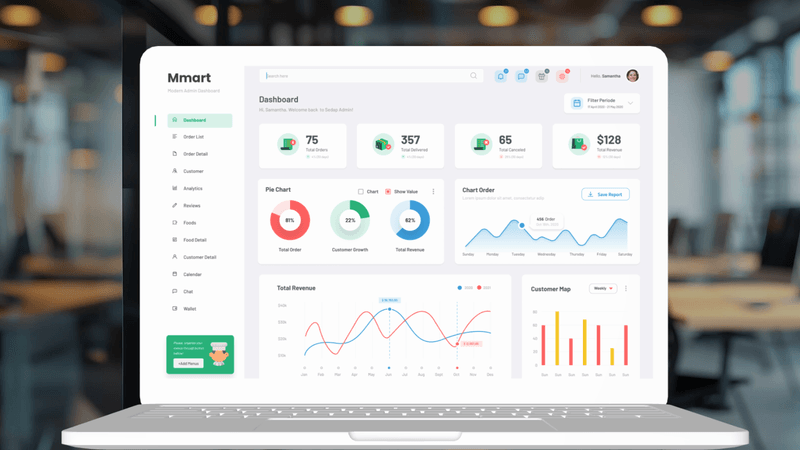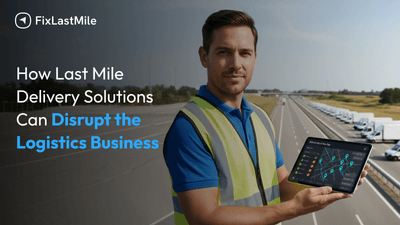Grocery shopping is changing. Today, many people do not want to go to the store, stand in line, and carry heavy bags home. They want to stay at home, order from their phone, and get fresh groceries delivered to their door. Fast, Easy & Comfortable. This way of shopping is now part of daily life for many families.
Studies say that online grocery shopping is growing fast and may hit $1 trillion by 2030. That is a very big number. It shows how fast things are changing in the grocery world. But delivering groceries is not always easy. The toughest part is the last mile, the step where the driver brings the groceries from the store to the customer’s home. This is the part where trouble often starts. Orders can be late, delivered to the wrong address, or lost. Customers may not know when their order is coming. It makes customers unhappy and also costs the store money.
To fix these problems, grocery stores now use smart tools like delivery software and real-time tracking. They help plan trips, show drivers where to go, and update customers on when to expect their groceries. In this blog, we will look at how these tools work, what problems they solve, and how they help stores give better service.
Grocery Stores Are Going Digital
In the past, grocery stores worked with paper and phone calls. But now, they are using computers and mobile apps to manage orders and deliveries. This helps everything run more smoothly and quickly.
Here is what usually happens:
- A customer orders on website or app
- The software picks a free driver
- The best route is chosen based on live traffic
- The driver gets the delivery details on their phone
- The customer gets updates about their order
- The manager can see everything on a dashboard
This whole system helps reduce mistakes and saves time for everyone.
What Happens When You Place a Grocery Order
Let’s take a look at what happens when someone places an order for groceries:
- The order is received: The grocery store gets the order on their system.
- A driver is assigned: The software picks the best and closest driver.
- The route is planned: The fastest way is selected using live maps.
- The driver picks up the groceries: They are loaded and ready to go.
- Live tracking starts: The store and customer can both see where the driver is.
- The groceries are delivered: The driver takes a photo or gets a digital signature for proof.
Thanks to tracking tools, this whole process is now fast, simple, and reliable.
Problems Stores Faced Before Using Delivery Software
Before these tools were available, stores faced many delivery problems:
- Orders arrived late or went to the wrong house
- Drivers could not find the customer’s address
- Customers didn’t know where their order was
- Some orders never left the store due to poor planning
- Stores had no proof if a customer said the order never came
- It was hard to manage many deliveries, especially on weekends
- Fuel and time were wasted on long or wrong routes
These problems caused stress for drivers, store workers, and customers.
How Tracking Software Helps
Now, let’s see how tracking tools make life easier for everyone involved in grocery delivery.
1. Helps Drivers Reach Faster
The software finds the shortest and fastest path. It also avoids traffic. This helps drivers get to the customer without delay.
2. Keeps Customers Updated
Customers get alerts on their phone or email. They know when the driver is coming and when the order has been delivered.
3. Reduces Mistakes
Drivers get clear instructions and directions. This helps them deliver to the right house without getting lost.
4. Gives Proof of Delivery
Drivers can take a photo or ask the customer to sign on the phone. This is saved as proof that the order was delivered.
5. Helps Managers Stay in Control
Store managers can watch all deliveries on one screen. They know where the drivers are and if any orders are late.
6. Saves Time and Fuel
The software picks better routes, drivers use less fuel and complete more orders in less time.
7. Handles Busy Days
Even when there are many orders, like on weekends or holidays, the system works without problems.
8. Grows with the Business
Whether the store is delivering 10 orders or 1,000, the software can handle it. It grows with the store.
Top Features of Grocery Delivery Software

Let’s look at the most important features of grocery delivery software—and how they help.
Live Driver Tracking
Everyone can see where the driver is at any time. This makes it easy to manage deliveries and keeps customers informed.
Smart Route Planning
The system picks the best path for every order. It avoids traffic and long roads. This helps drivers reach faster and saves money.
Real-Time Customer Updates
Customers get real-time updates when the driver leaves, nears their home, and delivers the order.
Time Slot Selection
Customers can choose a delivery time that suits them. The store can then plan routes based on those time slots.
Proof of Delivery
The driver can take photo or collect digital signature after delivering groceries. This helps in case the customer says they didn’t get the order.
Reports for Managers
Managers get reports showing delivery speed, driver performance, and delays to improve service quality.
Easy App for Drivers
Drivers can use the app on their phone. They get directions, delivery details, and can mark deliveries as complete right from the app.
One Screen for All Tasks
Managers can assign drivers, watch deliveries, check reports, and solve issues from one place. This saves time and avoids confusion.
Why Real-Time Tracking Is the Future
Today, people do not like waiting without knowing what’s happening. They want updates. They want to feel in control. And they want to trust that their groceries will arrive on time.
Real-time tracking gives them that control. It also helps the store give better service. When customers are happy, they come back. They tell others. And the store grows.
Real-time tracking is not just a good feature—it is a must for modern grocery delivery.
Building Trust with Good Delivery
Customers are happy when groceries arrive on time, in good condition, and with updates. They trust the store. They feel like the store cares about them.
But if the delivery is late, wrong, or missing, that trust is lost. Even one bad order can make a customer stop buying.
That’s why tools like tracking software and proof of delivery are so helpful. They build trust and keep customers coming back.
How These Tools Help Drivers
It’s not just about customers. These tools also help delivery drivers a lot.
Before, drivers had to use paper instructions or call for directions. If they couldn’t find the house, they wasted time.
Now, everything is in the app:
- The address
- The best route
- Delivery time
- Notes from the customer
This makes their job easier. It also helps them finish more deliveries in less time.
What Happens If You Don’t Use These Tools?
Some stores still use old methods like spreadsheets, phone calls, or paper lists. But this can cause big problems:
- Drivers take wrong roads
- Orders are late
- Customers keep calling to ask where their order is
- There is no proof of delivery
- Managers don’t know what’s going on
It led to unhappy customers and lost business.
Real Benefits Grocery Stores Are Seeing
Many stores that use tracking software are already seeing good results:
- Deliveries are 20–30% faster
- Less fuel is used
- Fewer mistakes happen
- Customers call less often to complain
- Drivers finish more trips
- Managers stay in control even on busy days
FAQs
It is a tool that helps stores plan, track, and complete grocery deliveries.
Yes. It is simple, works on phones, and helps stores of all sizes.
Yes. The system can handle many orders without problems.
Yes. It gives directions, delivery notes, and proof of delivery to avoid mistakes.
Yes. Most delivery tools have apps for both drivers and managers.




